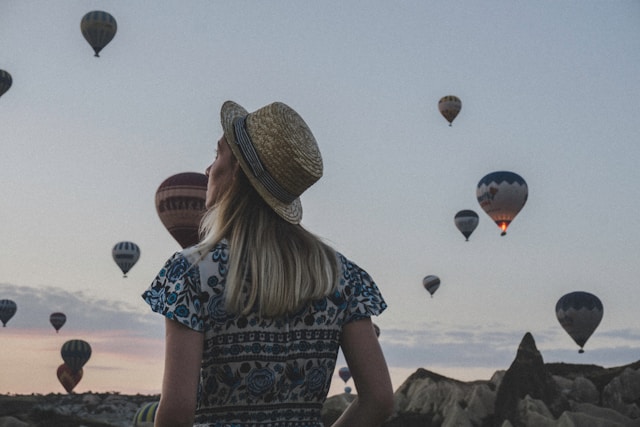Slow Travel: Ditching the Itinerary for Going with the Flow
6 min read
Charlotte Deville
Since the Pandemic, there has been a certain resurgence in the appeal of ‘slow travel’. The concept centres on “allowing the world to move just a little slower so that we actually notice it” and “taking the time to make a connection – to the land and each other”.
There is a real beauty to be found in living according to what feels right at the time
I tried and tested many related concepts on a recent trip to Nice, which I embarked on with nothing booked besides my flights. So, I can testify that there is real beauty to be found in living according to what feels right at the time, rather than blindly following a regimented itinerary of pre-planned time-pressures and booking constraints.
Slow travel emphasises immersing yourself in meaningful connections with the local culture, people you are travelling with, and truly authentic experiences. This requires a shift in mindset towards enjoying the present moment, losing track of time, exploring at your own pace, and prioritising high-quality experiences over rushing to jam-pack a vast quantity of tourist-trap activities into your time.
That’s not to say that you should go away, blind to what is on offer in your destination. Many slow travellers will embark on their trip with a rough sense of how they intend to spend their time, especially if there’s a ticketed activity they don’t want to miss out on.
However, I believe that finding the sweet spot of balance and prioritising the freedom to determine each day as it comes is where the optimum blissful experience lies.
So, why has slow travel resurged, and what are the benefits?
Slow travel was encouraged by Italian activist Carlo Petrini’s ‘Slow Food’ movement. In opposition to McDonald’s attempt to open their first Italian branch next to the Roman Spanish Steps, Petrini handed out home-cooked pasta to locals and tourists to signify the value of high-quality regional ingredients, cooking with care, and authentic local cuisine over fast food. This inspired the slow travel rejection of tourist culture and emphasis on anti-time-pressure, high quality, and true immersion in connections to the people and environment surrounding you.
The Pandemic has sparked a renewed interest in slow travel, with the restrictions encouraging many of us to re-invent our lifestyle and travel habits by turning to new hobbies, including walking, cycling, running, and hiking. Since then, a widespread appreciation for the mental and physical benefits of immersion in the outdoors has maintained its momentum. There’s a growing preference for simpler activities that provide a natural and lasting endorphin boost, such as going for a walk and truly connecting with nature and/or those accompanying you, over the fleeting oxytocin and destructive dopamine trip of draining your time on screens, indoor confinement, or retail therapy.
Immersing oneself in the present moment and connections with the people and environment surrounding us has been the key for many to discover what truly matters to them, and to ‘know’ their core values. It is surprising how little self-awareness we have when our time and energy is consumed by the pressures of the modern world.
- Rejecting and Resetting from Fast-Paced Modern Living
The biggest barrier to slow travel is people’s jobs, not their personal attitude
Over 50% of Americans continue to engage with work emails and calls whilst away, and find travel stressful, and 79.5% take only 3-7 days off work at a time. This time is extremely insufficient to slow down enough, so, unfortunately, the biggest barrier to slow travel is people’s jobs, not their personal attitude. This has led many to the important question of whether a job role that drains one’s time and energy and is confined to a schedule is valuable enough to strip away the freedom and opportunities for blissful travel experiences and a self-directed lifestyle that is truly one’s own. This is especially pertinent considering the sharp increase in digital nomad, freelance, or hybrid working opportunities as a solution to this.
For those still confined by their jobs though, slow travel appeals for the lack of necessary pre-trip planning, avoidance of hectic tourist traps and refusal to rush. Many also take this as an opportunity for a digital detox from social media.
Slow travel appeals for its potential for more unique experiences
Further statistics indicate that slow travel appeals for its potential for more unique experiences, such as discovering lesser-known places like a hidden beach or independent restaurant, and sight-seeing at non-peak times. Staying by the pool, shopping, and nightlife were the least popular incentives to travel, with trying local food and drink, discovering new cultures, and being in nature as the strongest motives in comparison. This desire for local authenticity explains the rise in culinary tourism based on independent businesses and local produce.
- Sustainability
For 31% of Americans, environmental concerns were at the forefront, with many conscious of the damage inflicted by mass-tourism and human activities. In the sinking city of Venice, for example, rising sea levels and pumping of groundwater contribute to its decline.
Slow travel promotes carbon-conscious transport, including trains, self-guided walking instead of rushing around on public transport, and longer stays in one destination instead of fleeting trips between multiple locations.
Furthermore, the desire for local goods, produce and experiences from independent businesses and merchants supports the local economy and reduces the carbon footprint associated with imported goods.
Sound appealing? Here are my recommendations and ideas for slow travel-inspired trips:
- Revisiting a destination you love is a great way to embrace slow travel, as a return trip provides a golden opportunity to experience those little restaurants, cafés, streets, parks etc you stumbled across but had no time to visit the first time around! This also means you have likely ticked-off many tourist spots and have greater familiarity with the area, so can revisit without the pressure of finding your bearings or going sight-seeing.
- Ask the locals for recommendations as they will be most aware of hidden gems! Perhaps they know a spot to watch the sunset, or a shabby-looking restaurant that serves the freshest, made-with-love dishes.
- Take note of local daily routines! What they eat and drink, what time they do so, how they travel around, and what activities they engage in are strong points of guidance to ensure an authentic experience for yourself.
- Activities:
- Browsing local markets
- People-watching over an evening (or morning) drink
- Taking a road trip: autonomy to stop and explore destinations en-route
- Sampling authentic street food
- Taking a bottle of wine to the beach or a sunset spot: Carmel Bunkers (Barcelona)
- Reading by the pool or sea
- Hiking, perhaps to a viewpoint, hill-top town or sight: Eze (French Riviera), Machu Picchu (Peru), the Olive Grove Trail (Switzerland)
- Self-guided walking tours: Walking & Wine at the Tuscan Wine School, walking safaris in Serengeti National Park
- Self-guided cycling: Sörmland region (Sweden Boat tours: canals to the windmills and tulip fields (Holland)
- Kyoto: exploring the temples, tea ceremonies, kaiseki (multi-course Japanese dinner), and staying in traditional ryokans (inns)
- Soaking up the Spanish sun, sea, Sangria, and seafood
- Puglia: with Italy being the most popular destination for slow travel, Puglia offers what is ideal for many: island hopping around the Tremiti, a culinary escape watching fishermen unload their catch in Gallipoli to later be served in local restaurants, the Gargano National Park, and many more idyllic beaches, olive oil farms, cookery schools and hilltop towns on offer.
So, what are you waiting for? Ditch the digital pressures, time constraints, tourist traps, and rigid agendas. Why not take an upcoming trip as an opportunity to slow down, thoroughly soak up the essence of your next destination, and truly connect with yourself and those around you.
Charlotte Deville
Featured image courtesy of Mesut Kaya via Unsplash. Image license found here. No changes were made to this image.
For more content including Uni News, Reviews, Entertainment, Lifestyle, Features and so much more, follow us on Twitter and Instagram, and like our Facebook page for more articles and information on how to get involved.
If you just can’t get enough of Lifestyle, like our Facebook as a reader or contributor.


